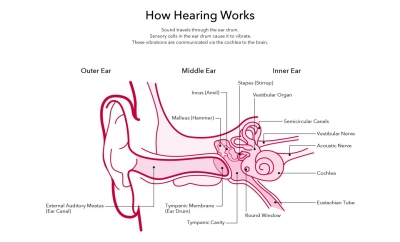
All sounds make invisible ripples, or waves, in the air. The ear collects sound waves and converts them first into vibrations, then into signals that the brain interprets as sounds.
Outer ear
Sound waves travel along the ear canal until they hit the eardrum and make it vibrate. The outer ear (pinna) ‘catches’ sound waves and directs them through the ear canal to the protected middle ear. These incoming sound waves cause the eardrum to vibrate. This is where the process of understanding these sound waves begins.
Middle ear
The vibrations pass through a series of bones, through the oval window, and into the cochlea. The middle ear is connected to the back of the nose and throat by the Eustachian tube. This means that when your loved one yawns or swallows, the Eustachian tube can open to equalise the pressure on both sides of the eardrum and prevent the membrane from being damaged.
Inner ear
Microscopic hairs inside the cochlea convert the vibrations into nerve signals, which are sent to the brain. The middle ear is connected to the back of the nose and throat by the Eustachian tube. This means that when your loved one yawns or swallows, the Eustachian tube can open to equalise the pressure on both sides of the eardrum and prevent the membrane from being damaged.
Loud and clear
The louder the sound, the bigger the vibrations it makes. Our ears are so sensitive that we can detect even the smallest sound, such as a paperclip dropping on the floor. We measure the loudness of sounds in decibels (dB).
Picture Credit : Google

